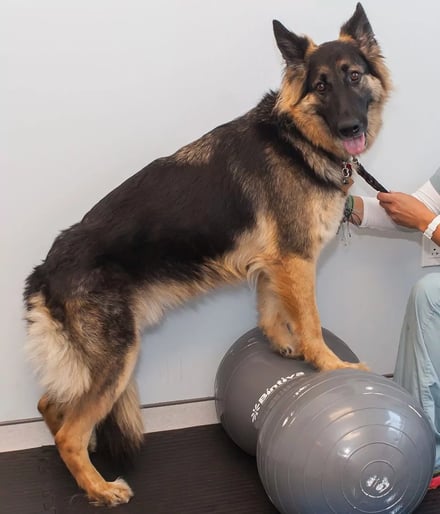Fibrocartilaginous Embolism (FCE) in Dogs
Home » Conditions We Treat » Fibrocartilaginous Embolism
What is fibrocartilaginous embolism?
Your dog is playing in the back yard when it suddenly cries out. When you come running to see what's wrong, you notice your dog is unable to use one of its rear limbs. Your dog doesn't seem to be in pain, so why can't it use its limb?
A relatively common cause of difficulty walking, a fibrocartilaginous embolism, or FCE in dogs, occurs when blood flow to the spinal cord is interrupted, causing a spinal stroke. Symptoms usually come on suddenly, often when a dog is being active, and typically affect one side of the body more than the other. Download the fact sheet.
Is your dog having difficulty getting around due to weakness or paralysis in one or more limbs? Our neurology specialists can help.
What causes FCE in dogs?
FCE in dogs happens when a small piece of fibrocartilage from a nearby intervertebral disc makes its way into the bloodstream and lodges in a blood vessel that supplies the spinal cord. When the spinal cord does not receive a constant blood supply, it cannot function, causing neurological symptoms of weakness or inability to use the limbs.
FCE can affect any breed of dog, however, large breed dogs are over-represented. There are a handful of small breed dogs that are known to be affected by FCE, most notably the Miniature Schnauzer.
How can I tell if my dog has FCE?
The main symptoms of FCE include a sudden onset of weakness on one side of the body (either one limb or both limbs on the same side). FCE is typically not painful, however, many dogs may cry out in pain at first or are anxious. Fortunately, signs of FCE do not continue to get worse after the first few hours.
It is important to note that there are many other spinal cord conditions that can look similar to FCE, but are treated very differently. While some may get better on their own, others may get worse without treatment. For this reason, it is very important to make an accurate diagnosis by doing tests. At Southeast Veterinary Neurology (SEVN), our veterinary neurologists have the technology and experience to accurately diagnose your dog.
Diagnosing FCE in Dogs
We will review your dog's history and perform a physical and neurological examination. Typically, an MRI and spinal tap (CSF analysis) are needed to definitively diagnose FCE and rule out other causes that may look just like it.
An MRI allows our neurologists to see inside the spinal cord and can also help determine a more accurate prognosis for your dog. These are things that CT scan, X-rays, and myelograms cannot show.

How can FCE be treated?

Fortunately, your dog will not have to undergo surgery if they have been diagnosed with FCE. Instead, we recommend physical rehabilitation and nursing care to help dogs with FCE heal and recover. Prognosis depends on the severity of clinical signs as assessed by a pet neurologist as well as certain aspects of the MRI. The majority of dogs with FCE have a good prognosis and can go on to lead happy, normal lives.

